Nina Liljeqvist
The Swedish Social Democratic Party (S) showed in last week’s general election how to win, without being much of a winner. The party did receive the most votes (31 %), and together with the other two opposition parties on the left – the Left party (V) (5,7 %) and the Greens (Mp) (6,9 %) – the red-green parties garnered 43,6 percent of the vote share. According to the final results just released by the election authority, this corresponds to 159 seats in parliament, which is short of the 175 needed for a parliamentary majority. The red-green block beat the four-party centre-right coalition by just over four percentage points. The resigning government coalition, the Alliance, consisting of the Moderates (M) (23,3 %), the Centre Party (C) (6,1 %), the Liberals (Fp) (5,4 %), and the Christian Democrats (4,6 %) received 39,4 percent of the votes, or 141 seats. Add to this the advance of far-right party Sweden Democrats (SD). With 12,9 percent of the votes and 49 seats, SD emerges as the third largest party in parliament and thereby also the absolute holder of the balance of power. As a result, the task of forming a government for S party leader Stefan Löfven may be described as unenviable at best.
From the campaign to the results
It seems to be a natural law in political science that the third term for the incumbent is tough to win. The centre-right coalition managed to form a majority when it first entered the political arena in 2006, and was later reduced to a minority government in 2010. Come 2014, the coalition parties found themselves fighting against public dissatisfaction with a number of welfare institutions, including but not limited to education and health care. First and foremost, voters punished the party of former PM Fredrik Reinfeldt and finance minister Anders Borg, as support for the Moderates declined by almost seven percentage points vis-à-vis the 2010 election. As the preliminary election results came in, Reinfeldt immediately handed in his resignation from office and also announced his withdrawal from the party in a few months. Who will take his place is still uncertain. Perhaps less upsetting, but the results were also negative for M’s three coalition partners Fp (-2 pp), Kd (-1 pp) and C (-0,4 pp). In other words, the centre-right block has lost over ten percentage points in support, but disappointed voters have not turned to new government members S and Mp.
Like most socialist parties around Europe, the Swedish Social Democrats have in recent years struggled with falling support and a decreasing number of party members. The party has also suffered from a turbulent internal situation, especially a streak of short-lived party leaders with much more long-lived faux pas. New party leader Stefan Löfven, former welder and union negotiator, has promised increased spending on schools and hospitals by raising taxes, positions seemingly well-received by the voters. However, the 31 percent vote share he achieved is nothing short of a disappointment. As party support has only grown by 0,4 pp, the vote share is quite a bit from the 35 percent the party had aimed for, not to mention the 45 percent support enjoyed during its heydays. Government partner the Greens is also not advancing with the electorate. Despite its immense success in the European Parliament election just a few months ago[1], Mp in fact decreased in support by 0,5 pp from their 2010 results.
The red-green win is, in other words, a win with rather muted cheers. They won not because they performed well in the campaign, but rather, because the centre-right did worse. Although the government coalition and Reinfeldt will resign, it is not with ease that Löfven will take his place. Throughout the campaign, Löfven has remained agnostic with regard to government formation. While the Left Party (V) never was much of government material – earlier this year V leader Jonas Sjöstedt gave Löfven the ultimatum to ban companies making a profit from tax-subsidised welfare – Löfven’s dismissal of inviting the party into government the very day after the election came somewhat as a surprise. It is a surprise since Löfven’s list of allies grows thin. Could-have-been side-kick Feminist Initiative (Fi) (3,1 %) is not an option as it fell short of the finish line, the 4-per cent-threshold. V, in turn, is extremely unhappy with Löfven’s post-election rejection. V will most probably regard the Social Democratic alternative as the lesser evil in this situation and support its budget, but even so, this is not enough to get a red-green budget passed in parliament. First and foremost, it is not enough to keep out the real winner of this election, far-right party Sweden Democrats (SD).
Nationalist party Sweden Democrats more than doubled support received in the 2010 election. Garnering a current 12,9 per cent of the vote share, the party emerges as the third largest party in parliament and thereby becomes the absolute holder of the balance of power. The party entered the riksdag for the first time in 2010 and has steadily climbed the opinion polls ever since. With such electoral success, the party will probably claim a position of deputy speaker, chairmanship in the parliamentary committees, etc. Time will tell if this may propel the party to become a party like any other. Throughout its first term in parliament, the other seven parliamentary parties ostracized the SD. This took place while SD voted in line with M about 70 percent of the time during the last parliamentary session. All remaining parties refuse to cooperate with SD due to its harsh stance on immigration and asylum. Sweden is unique in this regard, at least in the Nordic context, as nationalist parties have become more or less accepted in neighbouring countries. The Danish People’s Party has served as a support party of a minority government in Denmark, the Finns Party have been included in government negotiations in Finland, and the Progress Party formed a government last year with the Conservatives in Norway. [2] SD’s continuous surge in support raises the question of how long the established parties may insist in keeping it at an arm’s distance, and, what effect this strategy will have on SD support. Surely, parties can freely chose with whom to cooperate, and consequently whom to ostracize, but what range of options is possible in the rather cemented political arena that Swedish block politics have become?
Table 1 – Results of the 2014 Swedish parliamentary elections
Where to from here?
The clock is ticking for Löfven to form a government and proceed with budgetary negotiations. By mid-November at the very latest, Löfven should present a budget before parliament, and at the moment he does not even know with whom to work this budget out with. Not even talks with the one given coalition partner, Mp, is going to be straightforward. Throughout the campaign, Löfven shunned all talk of what a red-green government would look like, how portfolios would be distributed and on what issues cooperation with centre-right parties could be possible, come the situation that the red-green block would not get a parliamentary majority. Löfven’s mantra of “let’s wait and see until after the election”, perhaps went down with the voters, but he is sweating that strategy now. Mp is neither in a very admirable situation. The list of issues on which the two parties differ is long and includes at least green taxes, nuclear energy, migration, transportation, and defence. Most of these issues are affairs of the heart for green voters, but history has shown that Mp usually draws the shortest straw when in disagreement with S.
Apart from Mp, Löfven has met with party leaders of the Alliance over the course of the last week to discuss possible areas of cooperation. The two small parties at the centre, the Liberals and the Centre Party, are of particular interest. In order to rob SD of its hold over the balance of power, Löfven needs to find an agreement with both. To do this he needs to be willing to compromise quite generously, not least on taxes, and S’s recently suggested trainee programme for young unemployed, which was met with great scepticism by the Alliance. Yet such compromise is the most probable scenario for the coming months. Despite all this uncertainty, talk of re-election is very unlikely. Pragmatism usually prevails in Swedish politics and agreement across the two blocks will sooner or later come about. Such agreement is common concerning certain issues, for instance regarding free schools.
The two blocks are not that pragmatic, however, that they would opt for some kind of grand coalition, consisting of the red-greens, Fp and C. Löfven raised the possibility during the campaign, but the aggrieved centre-right block maintains that they much prefer the role of a watchful opposition that they now have been given. The electorate has a much more practical view on the matter. Recent opinion data reveal that 52 percent of the general public now wish to see a government consisting of parties from both the red-green and centre-right block. Only a week ago, 13 percent of voters wanted to see such a type of hung parliament which signal a drastic change in the mind of the median voter.[3] Such a change in the mind of the median member of parliament appears unlikely.
_______________________
Nina Liljeqvist is a PhD researcher in political science at the European University Institute, Florence, Italy and a research fellow at the Swedish parliament for the parliamentary session 2014/15. Her research interests lie in the area of comparative politics, and more specifically in representative democracy, European integration, and Nordic politics.
[1] Liljeqvist, Nina (2014) Svezia: la fuga dai grandi partiti, in Le Elezioni Europee 2014, Lorenzo De Sio, Vincenzo Emanuele e Nicola Maggini (eds.) /cise/2014/05/28/svezia-la-fuga-dai-grandi-partiti/
[2] Nina Liljeqvist and Kristian Voss (2012) What can other far-right parties tell us about the Sweden Democrats?, The Local, published 27 Nov 2012. https://www.thelocal.se/20121127/44694
[3] SVT News “Väljarna vill ha blocköverskridande regering “, published 19 September 2014: https://www.svt.se/nyheter/val2014/valjarna-vill-se-blockoverskridande-regering
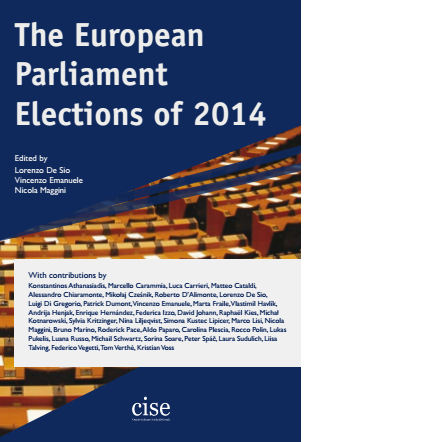
Introduction
Lorenzo De Sio, Vincenzo Emanuele and Nicola Maggini
Towards the European elections: An introductory framework
Vincenzo Emanuele and Nicola Maggini
Life of EP: History of the empowerment of the European Parliament
Rocco Polin
The evolution of turnout in European elections from 1979 to 2009
Nicola Maggini
Proportional representation with variable-geometry: Here is how to vote in the 28 member states
Vincenzo Emanuele
Expansion and electoral success: The winning strategy of the EPP
Vincenzo Emanuele
United but loser? The PES between party cohesion and electoral decline
Michail Schwartz
The Alliance of Liberals and Democrats for Europe Group: Towards an inevitable decline?
Bruno Marino
From the Italian Communist Party to Tsipras: The path of Europe’s radical left
Federica Izzo
The populist and Eurosceptic right: The evolution of its electoral success
Nicola Maggini
Electoral results: The PD from the “majoritarian vocation” to its realisation
Nicola Maggini
High fidelity and new votes for Renzi
Roberto D’Alimonte
Vote shifts in Rome and Milan confirm the frame of Renzi’s victory
Aldo Paparo and Matteo Cataldi
The Italian party system between change and stabilisation on new basis
Alessandro Chiaramonte and Vincenzo Emanuele
Where does Renzi’s victory come from?
Lorenzo De Sio
Austria: No one loses, all win?
Carolina Plescia and Sylvia Kritzinger
The Baltic states: Mixed results for incumbents
Liisa Talving and Lukas Pukelis
Belgium: Far beyond second order
Tom Verthé
Bulgaria: To support or not to support the government in power, this is the dilemma
Sorina Soare
Croatia: Negative results for the government coalition
Andrija Henjak
Cyprus: Disapproval through abstention in the European Union’s remotest ‘outpost’
Konstantinos Athanasiadis
The Czech Republic: Where have all the voters gone?
Vlastimil Havlík
Denmark and Finland: (not always) a success for the far-right
Nina Liljeqvist and Kristian Voss
France: The historic victory of the Front National
Luana Russo
Germany: Merkel does not stand out but holds
Carolina Plescia and David Johann
Greece: Historic change or alarm bell?
Konstantinos Athanasiadis
Hungary: The stability of Fidesz’s domain
Federico Vegetti
Luxembourg: The first European Parliament–only vote
Patrick Dumont and Raphaël Kies
Malta: Hidden change?
Marcello Carammia and Roderick Pace
Poland: Old turnout and new right
Mikołaj Cześnik and Michał Kotnarowski
Portugal: Between apathy and crisis of mainstream parties
Marco Lisi
Romania: A preview of the 2014 presidential elections?
Sorina Soare
Slovakia: Record holder in the lowest turnout
Peter Spáč
Slovenia: Internal political crisis and the success of the opposition
Simona Kustec Lipicer
Spain: The beginning of the end of bipartisan rule?
Enrique Hernández and Marta Fraile
Sweden: An escape from mainstream parties
Nina Liljeqvist
Netherlands, Ireland and UK: Euroscepticism does (not) triumph
Laura Sudulich
A turnout like in 2009 but with many “Europes” within the EU
Nicola Maggini
EPP loses votes and seats but remains the first party in the European Parliament
Vincenzo Emanuele
The Party of European Socialists: Stability without success
Luca Carrieri
German and UK’s Liberals collapse and ALDE loses ground
Bruno Marino
The radical left grows but only in the South of Europe
Michail Schwartz
The electoral progress of the populist and Eurosceptic right
Nicola Maggini
A “revolutionary” election: The Italian party system is the most simplified in Europe
Luigi Di Gregorio
Conclusions
Lorenzo De Sio, Vincenzo Emanuele and Nicola Maggini

edited by Lorenzo De Sio, Vincenzo Emanuele and Nicola Maggini
The European Parliament elections of 22-25 May 2014 had already been anticipated, before the vote, as potentially so relevant to become the first “true” European elections. Not only because of the economic crisis – which in recent years has seen the emergence of EU (and international) institutions as key players of economic policy for Euro member states, with relevant effects for the everyday life of citizens – but also due to the entry into force of the Lisbon Treaty, which has reinforced the link between the popular vote and the election of the President of the EU Commission. In this context, several commentators had anticipated a potential inadequacy of the consolidated theoretical framework that conceptualizes EP elections as second-order elections. In particular, European issues could be expected to gain a substantial importance in electoral campaigns, with a potential success of Eurosceptic parties due to their ability to politicize – in a negative direction – issues related to Europe and the Euro. A further question is then related to Italy: the third Eurozone economy, on the eve of assuming the Presidency of the EU, and with a government led by a young and energetic Matteo Renzi, but lacking an electoral legitimation. Also, a country that in 2013 saw the largest success of an anti-establishment party ever recorded in Europe. This leads to the main questions behind this book. What were electoral outcomes across Europe? Are we observing the first true first-order European elections? What factors might explain the heterogeneous electoral fortunes of Eurosceptic parties? And how should we interpret the success of the Renzi government in Italy?
This book addresses these questions by presenting analyses performed by a large, international research group: for the first time, the CISE has expanded beyond its core group of Italian researchers, by assembling an additional research group of 26 young, brilliant electoral scholars from all across Europe. This allowed us to publish on the CISE website – few days after the elections – concise electoral reports about all 28 EU countries, which are now collected in this book, together with other analyses by the CISE core group. The result is a unique effort, providing – few weeks after the vote – fresh and detailed data, along with first interpretations of electoral results in all EU countries, in order to help practitioners, citizens and scholars develop a first impression – and overall interpretation – of these crucial European elections.
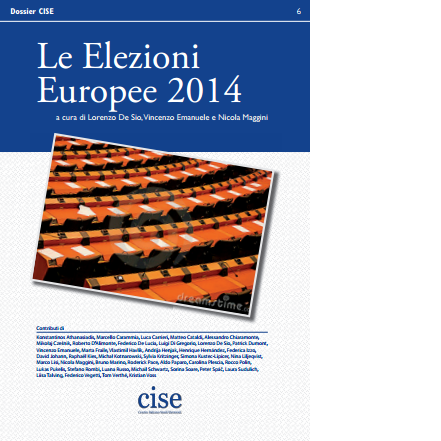
Introduzione
Lorenzo De Sio, Vincenzo Emanuele e Nicola Maggini
Verso le elezioni europee, un quadro introduttivo
Vincenzo Emanuele e Nicola Maggini
Vita di PE: l’evoluzione storica del Parlamento Europeo e dei suoi poteri
Rocco Polin
L’evoluzione dell’affluenza alle elezioni europee dal 1979 al 2009
Nicola Maggini
Proporzionale a geometria variabile. Ecco come si vota nei 28 paesi membri
Vincenzo Emanuele
Le scelte degli europartiti: chi sono i candidati alla Presidenza della Commissione e come sono stati selezionati
Bruno Marino
Allargamento e successo elettorale: la strategia vincente del PPE
Vincenzo Emanuele
Unito ma perdente? Il PSE tra coesione partitica e declino elettorale
Michail Schwartz
Il gruppo dell’ALDE: un inevitabile ridimensionamento?
Bruno Marino
Dal PCI a Tsipras. Il cammino della sinistra radicale in Europa
Federica Izzo
La destra populista ed euroscettica: l’evoluzione della sua affermazione elettorale
Nicola Maggini
Le elezioni europee del 2014 in Italia: la situazione di partenza
Nicola Maggini e Vincenzo Emanuele
La competizione elettorale europea durante il ciclo bipolare italiano
Luca Carrieri
Chi risolverà i problemi dell’Italia? Partiti, obiettivi e credibilità
Lorenzo De Sio
Affluenza, un calo atteso. Al Sud 1 su 2 si astiene
Vincenzo Emanuele
I risultati elettorali: il Pd dalla vocazione all’affermazione maggioritaria
Nicola Maggini
Il Pd vince dappertutto, anche nel Nord-Est
Roberto D’Alimonte
La competizione nelle province: dietro al Pd c’è ovunque il M5s, con Fi terza
Aldo Paparo e Matteo Cataldi
Renzi, alta fedeltà e nuovi voti a 360°
Roberto D’Alimonte
I flussi a Roma e Milano confermano il quadro della vittoria di Renzi
Aldo Paparo e Matteo Cataldi
Il sistema partitico italiano tra cambiamento e stabilizzazione su basi nuove
Alessandro Chiaramonte e Vincenzo Emanuele
Il voto di preferenza: tra meridione, neo-democristiani e intellettuali
Stefano Rombi
Fi si salva alle Europee anche grazie alla concomitanza con le comunali
Aldo Paparo e Matteo Cataldi
Eletti 2014: anche in Europa cambia tutto. Giovani, donne ed esordienti
Federico De Lucia
Da dove viene la vittoria di Renzi?
Lorenzo De Sio
Austria: nessuno perde e tutti vincono?
Carolina Plescia e Sylvia Kritzinger
Belgio: elezioni di terz’ordine
Tom Verthé
Bulgaria: sostenere o non sostenere il governo in carica, questo è il dilemma
Sorina Soare
Cipro: astensionismo di protesta ai confini dell’Europa
Konstantinos Athanasiadis
Croazia: risultati negativi per la coalizione al governo
Andrija Henjak
Finlandia e Danimarca: tra destra radicale e partiti moderati tradizionali
Nina Liljeqvist e Kristian Voss
Francia: la vittoria storica del Front National
Luana Russo
Germania: la Merkel non trionfa ma regge
Carolina Plescia e David Johann
Grecia: cambiamento storico o semplice campanello d’allarme?
Konstantinos Athanasiadis
Lussemburgo: il primo voto “solo” europeo
Patrick Dumont and Raphaël Kies
Malta: mutamento sottotraccia?
Marcello Carammia e Roderick Pace
L’anti-europeismo (non) sfonda: il voto in Olanda, Irlanda e Regno Unito
Laura Sudulich
I paesi baltici: risultati ambigui per i governi in carica
Liisa Talving e Lukas Pukelis
Polonia: tra vecchia astensione e nuova destra
Mikolaj Czesnik e Michal Kotnarowski
Portogallo: apatia e crisi dei partiti moderati
Marco Lisi
Repubblica Ceca: dove sono finiti gli elettori?
Vlastimil Havlík
Romania: un’anticamera delle presidenziali dell’autunno 2014?
Sorina Soare
Slovacchia: record assoluto di astensione
Peter Spác
Spagna: l’inizio della fine del bipartitismo?
Enrique Hernández e Marta Fraile
Svezia: la fuga dai grandi partiti
Nina Liljeqvist
Ungheria: la stabilità del predominio di Fidesz
Federico Vegetti
Affluenza come nel 2009, ma tante “Europe” dentro la Ue
Nicola Maggini
Il PPE perde voti e seggi, ma rimane il primo gruppo nel Parlamento Europeo
Vincenzo Emanuele
Il Partito Socialista Europeo: stabilità senza successo
Luca Carrieri
Crollano i Liberali in Germania e nel Regno Unito, l’ALDE arretra
Bruno Marino
La sinistra radicale cresce, ma solo nel Sud Europa
Michail Schwartz
L’avanzata elettorale della destra populista ed euroscettica
Nicola Maggini
Un voto “rivoluzionario”: il sistema dei partiti più semplificato è quello italiano
Luigi Di Gregorio
Conclusioni
Lorenzo De Sio, Vincenzo Emanuele e Nicola Maggini
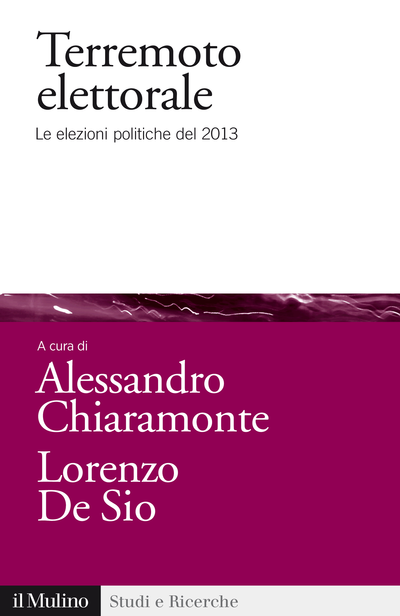
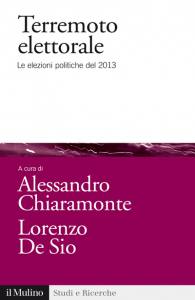 A. Chiaramonte, L. De Sio (a cura di)
A. Chiaramonte, L. De Sio (a cura di)
Terremoto elettorale. Le elezioni politiche del 2013
Bologna, Il Mulino, 2014
ISBN 978-88-15-25172-5
Un terremoto: così si può definire il risultato elettorale del 2013, con un sistema che da bipolare diventa a «tre poli e mezzo», e il M5S che dal nulla diventa il primo partito, sospinto da oltre otto milioni di voti. Per la prima volta, dalla fine della Prima Repubblica, a determinare l’esito non è solo una bizzarra legge elettorale, né le scelte coalizionali dei partiti: è invece un massiccio cambiamento nelle scelte di voto degli elettori. Di qui la necessità di un’analisi rigorosa e approfondita di queste elezioni cruciali, che il libro affronta a tutto campo: dalla costruzione dell’offerta politica alla campagna elettorale, dalle dinamiche dell’astensionismo a quelle del voto e dei flussi elettorali, dalla novità del M5S al significativo ricambio della classe politica.

a cura di Lorenzo De Sio, Vincenzo Emanuele e Nicola Maggini
Le elezioni europee del 22-25 maggio 2014 apparivano, già alla vigilia, tanto rilevanti da essere potenzialmente candidate a divenire le prime “vere” elezioni europee. La crisi economica scoppiata nell’autunno del 2008 ha fatto emergere in questi anni le istituzioni dell’Unione Europea come il principale centro decisionale in materia di politica economica degli stati dell’Eurozona, e più in generale come attore capace di incidere fortemente sulla vita dei cittadini europei. Inoltre, l’entrata in vigore del Trattato di Lisbona ha rafforzato il legame tra il voto popolare e l’elezione del Presidente della Commissione, spingendo così verso una maggiore rilevanza di queste elezioni europee. (https://www.top5.com/) Sulla base di questi presupposti molti commentatori avevano, alla vigilia, messo in discussione il consolidato framework teorico che inquadra le elezioni europee come second order elections. In particolare, ci si attendeva una maggiore centralità delle tematiche europee e un successo dei partiti euroscettici, i più abili a politicizzare – in chiave negativa – i temi legati all’Europa e all’euro. Con specifico riferimento al caso italiano, invece, queste elezioni rappresentavano un cruciale banco di prova per i partiti all’indomani del terremoto elettorale del 2013 e soprattutto per il nuovo governo di Matteo Renzi, arrivato al potere senza il vaglio delle urne. Qual è stato l’esito delle elezioni europee? Si è trattato delle prime first order elections? Quali fattori spiegano il successo territorialmente differenziato dei partiti euroscettici? E come interpretare il successo del PD di Matteo Renzi in Italia?
Questo sesto Dossier CISE, oltre a contenere le analisi pubblicate sul sito web CISE prima e dopo le elezioni (riguardanti sia il contesto italiano che quello europeo) presenta inoltre un’importante novità: per la prima volta il Cise ha assemblato un gruppo di ricerca di 22 giovani studiosi di tutta Europa, che ha permesso di analizzare in tempi rapidissimi – con brevi report su ciascun paese – il risultato elettorale in tutti e 28 i paesi dell’Unione Europea. Il risultato è un lavoro comparato di fatto unico in ambito internazionale, prodotto poche settimane dopo il voto con l’obiettivo di fissare alcuni primi dati, e di suggerire dei primi spunti di interpretazione sugli esiti di queste cruciali elezioni europee.
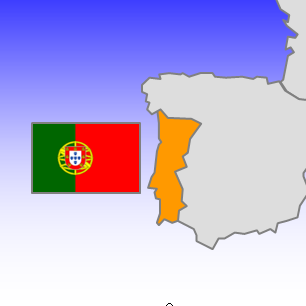
Marco Lisi
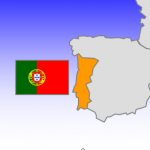 Portugal is experiencing a huge economic and social crisis that has not triggered – at least until now – significant changes in the political system, as it happened in Greece or Italy. The financial default of the Portuguese state led the three main parties – the Socialist Party (PS), the Social-Democratic Party (PSD)[1] and the Social-Democratic Centre-Popular Party (CDS-PP) – to sign in April 2011 a three-year bailout with the so-called troika (International Monetary Fund, European Commission and European Central Bank). The memorandum of understanding established the implementation of structural reforms based on a neoliberal agenda in exchange for a 78 billion euros bailout (Moury and Freire 2013). The program terminated just when the electoral campaign took off (4 May) and inevitably influenced not only party programmatic orientations, but also the political debate and the main issues of competition. The 2014 European elections were thus the opportunity for Portuguese voters to evaluate the austerity policies adopted by the right government (PSD and CDS-PP) led by Prime Minister Pedro Passos Coelho (in office since June 2011).
Portugal is experiencing a huge economic and social crisis that has not triggered – at least until now – significant changes in the political system, as it happened in Greece or Italy. The financial default of the Portuguese state led the three main parties – the Socialist Party (PS), the Social-Democratic Party (PSD)[1] and the Social-Democratic Centre-Popular Party (CDS-PP) – to sign in April 2011 a three-year bailout with the so-called troika (International Monetary Fund, European Commission and European Central Bank). The memorandum of understanding established the implementation of structural reforms based on a neoliberal agenda in exchange for a 78 billion euros bailout (Moury and Freire 2013). The program terminated just when the electoral campaign took off (4 May) and inevitably influenced not only party programmatic orientations, but also the political debate and the main issues of competition. The 2014 European elections were thus the opportunity for Portuguese voters to evaluate the austerity policies adopted by the right government (PSD and CDS-PP) led by Prime Minister Pedro Passos Coelho (in office since June 2011).
The electoral campaign
The electoral campaign started with the debate about the “post-troika” scenarios, that is, whether Portugal would follow the Irish example with a “clean exit” from the external intervention or whether the government would request a program of financial assistance. While the government announced the decision to reject additional aids, the electoral competition focused on the responsibility of the two main parties to cause the external intervention and the austerity policies that followed the bailout (see Magalhães 2014). The PS’ strategy aimed to make the European elections a referendum against the government, blaming the right coalition to aggravate the economic and social situation with its neoliberal orthodoxy. On the other hand, Passos Coelho emphasized the successful exit from the program and the socialists’ bad management of the 2008 crisis, considering the PS the only responsible for the Troika intervention. The campaign developed towards an increasing personalization around the former socialist Prime Minister José Sócrates (in office from 2005 to 2011), who was addressed by right parties as the main blamable for the economic and financial crisis.
| Marco Lisi is professor of political science at the Department of Political Studies at the New University of Lisbon. His research interests include political parties, political behavior, electoral campaigns and public opinion. |
Radical left parties campaigned more on European issues than governing parties. The Portuguese Communist Party (PCP) – one of the most orthodox communist parties in Europe (March 2011) – has always adopted euro-skeptic stances, severely criticizing both the political and economic dimensions of European integration (Lobo and Magalhães 2011). In the electoral campaign this criticism assumed clear nationalist tones due to the external intervention. Besides this, the communists accused the three main governing parties (PS, PSD and CDS-PP) to represent the “domestic troika”. On the other hand, the Left Block (BE) adopted a relatively positive position towards the political integration of the European Union, although it severely criticized the economic and social dimensions (Fernandes and Pereira 2014).
While the right coalition presented a pre-electoral alliance through a joint list of candidates under the label “Portugal Alliance”, the left was much more fragmented. Two new forces emerged from the BE: the MAS (Socialist Alternative Mouvement) and the LIVRE, led by the ex-MEP Rui Tavares. The first is an extremist left party with strong euro-skeptic positions, whereas the second displays a positive – but critical – stance towards the EU and a more open attitude towards the socialists.
The results: a bitter victory or a sweet defeat?
Portugal elects 21 MEPs, one less than in the previous European elections. The vote is based on a proportional system with a national district and closed party lists.
The first important aspect to notice is the increase in the abstention rate. In these elections the abstention achieved an historical 66.1%, almost three percentage points more than the 2009 score (63.2%). The level of turnout has steadily decreased over the years (it was 72.4% in 1987), but in these elections the abstention rate has been substantially higher than previous legislative or presidential elections.
The second interesting aspect is the marginal victory of the main opposition party. Taking into account the expectations of the socialist leadership, the result obtained by the PS (31.5%) has a bitter taste, especially if we consider that the competition presented ideal conditions for an excellent performance of the opposition. The extremely high levels of government dissatisfaction, high rates of prime minister’s unpopularity, as well as high levels of unemployment (more than 15%) and a difficult economic recovery were all factors playing in favor of the PS.
Actually the “perfect storm” for the right government did take place, and this is confirmed by the results of the right coalition: 27.7% of the votes and the election of 7 MEPs (three less than the 2009 elections). The final results were disappointing even considering the worst scenario prospected before the elections. The two right parties lose votes throughout the country, especially in the north, which is their traditional stronghold.
| Table 1 – Results of the 2014 European Parliament elections – Portugal | ||||||
| Party | EP Group |
Votes (%) |
Seats |
Votes (change from 2009) |
Seats (change from 2009) |
|
| Socialist Party (PS) |
S&D |
31.1 |
8 |
+5.0 |
+1 |
|
| Portugal Alliance (AP) |
EPP |
27.7 |
7 |
-12.4 |
-3 |
|
| Democratic Unitarian Coalition (CDU) |
GUE-NGL |
12.7 |
3 |
+2.1 |
+1 |
|
| Earth Party (MPT) |
NI |
7.1 |
2 |
+6.4 |
+2 |
|
| Left Bloc (BE) |
GUE-NGL |
4.6 |
1 |
-6.1 |
-2 |
|
| Others |
9.3 |
0 |
||||
| Blank ballots |
4.4 |
|||||
| Invalid votes |
3.1 |
|||||
| Total |
100 |
96 |
– |
|||
| Turnout (%) |
48.1 |
+4.8 |
||||
| Legal threshold for obtaining MEPs (%) |
none |
|||||
| Note: The difference of votes and seats of the Portugal Alliance (AP) has been calculated considering the sum of votes and seats of the Social Democratic Party (PSD) and of the People’s Party (CDS–PP) in the 2009 elections.
EP group abbreviations: EPP=European People’s Party; S&D=Progressive Alliance of Socialists and Democrats; ALDE=Alliance of Liberals and Democrats for Europe; G-EFA=The Greens–European Free Alliance; ECR=European Conservatives and Reformists; GUE-NGL=European United Left–Nordic Green Left; EFD=Europe of Freedom and Democracy; NI=Non-Inscrits. |
||||||
Despite the collapse of the government, the PS was not able to benefit from voters’ dissatisfaction towards the austerity policies. Who won then the elections? Two contenders were particularly successful. The first is the PCP, which increased both its number of MEPs (from two to three) and its vote share. However, the main surprise came from the MTP, an ecologist party which has always had a poor performance in both European and legislative elections (below 1% of the votes). In the 2014 elections the MPT obtained 7.1% of the votes, electing two MEPs. This success was due, in the first place, to its top-candidate Marinho e Pinto, an ex-journalist and well know lawyer. In addition, this excellent result was based on its anti-establishment discourse: the MPT not only campaigned in favor of the renewal of the political elite, but also against Brussels’ technocracy, its disproportionate bureaucracy and the lack of legitimacy of its political elite. Many observers did not hesitate to criticize the populist nature of this discourse, although deprived of the direct democracy component typical of populist parties. Despite this, the MPT rejects the euro-skeptic position adopted by the two radical left parties, displaying a rather vague orientation on this topic. The distribution of the vote is relatively homogeneous, which reflects the gains of the votes from the two main moderate parties. The MPT performed very well in some districts in the North and the coast (Porto, Aveiro, Viana do Castelo, Coimbra), while in the south its vote share is above the national average.
To conclude the analysis of election results, we need to emphasize the defeat of the BE (just 4.6% of the votes) and the poor performance of the LIVRE (2.2%). The protest vote against the austerity policies inflated blank and invalid votes, which achieved significant figures (3.1% and 4.4%, respectively).
Conclusions
The results of the 2014 European elections will certainly influence the next legislative elections (scheduled for 2015). The poor performance of the socialists has strengthened internal criticism towards the leader and a competition for the leadership is taking place. António José Seguro, the PS secretary-general, will compete against António Costa, the mayor of Lisbon, who seems more popular and more effective than the current leader. On the other hand, the results of the right coalition, although negative, seems to give them some chances for the next electoral contest, especially if we take into account the relatively positive evolution of the economy forecasted for the next year. However, it is still unknown whether the two parties will present separate lists or whether they will form a pre-electoral alliance as happened in the last European elections. Radical left parties are also expected to change their strategy, especially the BE and the LIVRE, with the aim to consolidate their popularity and increase their competitiveness with regard to the PCP.
The main lesson that we can draw from these elections is the crisis of the main parties to maintain their basis of support, while dissatisfaction towards the political elite is growing fast. The high levels of mistrust towards parties, the lack of clear alternative programs and the growing distance between parties and citizens are some of the main problems that moderate parties have to solve in order to avoid a political earthquake. The semi-presidential system, the significant impact of leaders on voters’ choice and the mass media personalization are some of the elements that pose serious threats to the hegemony of the main governing parties. Portuguese voters have already displayed their availability for new solutions and alternatives. It remains to be seen whether traditional parties will learn the lesson or whether they will ignore the need of change that comes from civil society.
References
Fernandes, Jorge M. and Pereira, José Santana (2014), “Os programas eleitorais das europeias de 2014: uma análise preliminar das principais dimensões de competição”, Relações Internacionais, 41 (March), pp. 81-95.
Lobo, Marina Costa, and Pedro C. Magalhães (2011) “Room for Manoeuvre: Euroscepticism in the Portuguese Parties and Electorate.” South European Society and Politics 16(1), pp. 81-104.
Magalhães, Pedro C. (2014), “The Elections of the Great Recession in Portugal: Performance Voting under a Blurred Responsibility for the Economy”, Journal of Elections, Public Opinion and Parties, 24 (2), pp. 180-202.
March, Luke (2011) Radical Left Parties in Europe. London: Routledge.
Moury, Catherine and Freire, André (2013), “Austerity Policies and Politics: the case of Portugal”, Pôle Sud – Revue de Science Politique, 39 (2), pp. 35-56.
[1] The Social-Democratic Party is a conservative-liberal party affiliated to the European Popular Party.
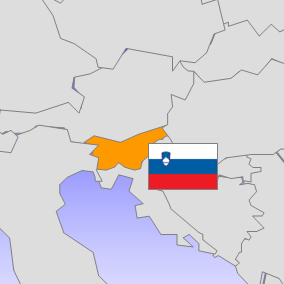
di Simona Kustec Lipicer
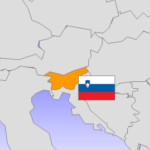
L’Unione Europea è stata quasi completamente assente dalle terze elezioni slovene per il Parlamento Europeo. La campagna per le elezioni europee ha avuto luogo in una fase di profonda crisi della politica slovena, sebbene anche in precedenza non si era rilevato alcun segno tangibile riguardante le elezioni europee né fra i partiti politici, né fra la cittadinanza né fra i media.
Alla fine i risultati elettorali hanno in qualche modo confermato il carattere tipicamente di “secondo ordine” (Reif e Schmitt 1980) delle elezioni del Parlamento Europeo (PE), caratterizzate dal successo dei partiti di opposizione e di forze politiche alternative, sebbene i risultati del 2014 debbano prima di tutto essere ricondotti al contesto politico nazionale dell’intero periodo pre-elettorale. Le determinanti principali del risultato elettorale sloveno sembrano essere riconducibili sia a fattori di livello micro (i partiti nazionali), sia a condizione di livello macro (relative allo stato).
Le circostanze politiche domestiche come fattori determinanti delle elezioni europee
In generale l’atteggiamento dei partiti parlamentari sloveni nei confronti delle elezioni europee è stato molto distaccato. Sia la coalizione di governo che i partiti di opposizione non hanno dichiarato ufficialmente né il programma né la lista dei candidati fino a quasi un mese prima delle elezioni, quando cioè stava per scadere il termine per la presentazione delle liste. I partiti dunque non hanno sviluppato alcun sentimento di identità relativo all’Unione Europea (UE) e perfino i partiti che avevano dei parlamentari uscenti hanno fatto riferimento molto raramente al loro lavoro a Bruxelles.
| Simona Kustec Lipicer è Professore Associato e Ricercatore presso la Facoltà di Scienze Sociali dell’Università di Lubiana. I suoi interessi di ricerca vertono sugli studi elettorali, specialmente il comportamento elettorale, la campagna elettorale, le posizioni e le preferenze di policy, nonché sull’analisi delle politiche pubbliche e della valutazione politica. |
L’atteggiamento dei partiti nei confronti dell’UE potrebbe essere spiegato – sebbene solo parzialmente – con il basso livello di fiducia dell’opinione pubblica slovena nei confronti dell’UE e con le richieste da parte di Bruxelles nei confronti del paese che per lungo tempo è stato visto come uno dei più probabili candidati a ricevere la “visita della Troika”. Dall’altra parte, la crisi interna dei a) partiti politici domestici, b) dell’arena parlamentare e anche c) dell’arena governativa, insieme con un basso livello di cultura politica che si declina in un basso livello di soddisfazione e fiducia nei confronti della politica (Toš et al. 2014), possono spiegare l’atteggiamento distaccato verso le elezioni del PE nel paese.
All’inizio del 2014 una grave crisi interna ha colpito il partito leader della coalizione di governo, Slovenia Positiva (PS), portando il partito alla divisione in due correnti. La prima vicina al Primo Ministro Bratušek e intenzionata a seguire l’agenda della coalizione di governo, la seconda guidata dal padre fondatore Janković, sindaco di Ljubljana, che aveva bisogno di staccarsi dalle posizioni del presidente del partito a causa delle accuse di corruzione.
Allo stesso tempo, anche il secondo maggior partito di coalizione, il partito Social-democratico (SD), si sono ritrovati a combattere una dura lotta interna per la leadership, terminata con la quasi auto-candidatura del leader del partito quale titolare della lista per le elezioni europee. Il terzo membro della coalizione, il partito dei pensionati (DeSUS) aveva dichiarato all’inizio dell’anno che non avrebbe preso parte alle elezioni europee perché, attendendosi un insuccesso, aveva preferito non affrontare i costi della campagna. Successivamente, il partito presentò comunque la lista, appaltandola all’europarlamentare uscente Vajgl, eletto nel 2009 con la lista “Davvero” (Zares) ma che aveva successivamente visto sciogliersi la propria struttura partitica.
Allo stesso modo, il principale partito di opposizione, il Partito democratico sloveno (SDS), affrontava la propria crisi interna, principalmente dovuta ai processi del presidente del partito Janša accusato di aver preso tangenti negli appalti di attrezzature militari della finlandese Patria Oyj. Gli altri due partiti di opposizione, il partito del popolo sloveno (SLS), di centro-destra, e Nuova Slovenia Cristiano-democratica (NSi), avevano deciso di formare una coalizione pre-elettorale e affrontare le elezioni per il PE con una lista comune. Si trattava del primo tentativo di alleanza fra partiti dello schieramento di centro-destra alle elezioni europee. La Lista dei Cittadini (DL), quarto partito di opposizione e – proprio come il membro della coalizione di governo Slovenia Positiva (PS) – un esordiente di grande successo alle elezioni politiche del 2011, al momento delle elezioni europee è stato colpito da problemi interni che hanno negativamente influenzato la sua capacità di competere alle elezioni europee.
Sull’onda dei movimenti di protesta della società civile che si sono sviluppati alla fine del 2013, sono stati formati alcuni nuovi partiti (come Solidarnost), fra cui un partito leader-centrico (Credere, guidato dall’ex presidente della Corte dei Conti, Šoltes) e un nuovo partito guidato dall’ex europarlamentare Kacin (ex Liberal-democrazia della Slovenia (LDS) nella legislatura 2009-2014, adesso candidato della propria “Lista Kacin”) che aveva perso per strada la propria base partitica, dal momento che LDS era scomparso dalla scena politica durante la legislatura 2009-2014.
La campagna
In un contesto così confuso non appare sorprendente che la campagna elettorale europea in Slovenia sia stata corta, vaga e non strutturata. E’ stata un misto di campagne di vario tipo, dalle pre-moderne, alle moderne fino alle post-moderne (Farrell e Schmitt‐Beck 2002; Whiteley e Seyd 2003). La campagna del partito vincitore, SDS, si è resa riconoscibile per l’uso di una comunicazione interpersonale diretta e il sostegno giunto da altri politici europei; la campagna del secondo miglior partito, NSI-SLS, si è invece distinta per l’utilizzo di un modello in stile USA, mentre invece la campagna di SD, che ha vinto un seggio, ha seguito, eccetto alcuni momenti negativi, un approccio simile a quello di SDS. La campagna di Credere, la lista di Igor Šoltes, è stata diretta a lanciare Šoltes come un attore nuovo e positivo sulla scena politica slovena (Rtvslo 2014; Siol 2014). Le campagne dei partiti sono state principalmente condotte attraverso i siti e i social networks (come Facebook e Twitter) di partiti e candidati. Le tecniche e gli strumenti tradizionali delle campagne elettorali sono stati utilizzati in forma molto limitata.
Quasi tutti i partiti concorrenti hanno preparato brevi programmi elettorali disponibili sui loro siti internet. I principali temi enfatizzati nei programmi erano relativi al tema del deficit democratico dell’UE, al tema delle relazioni tra Slovenia e UE e più specificamente vertevano su tematiche relative all’economia, alla finanza, all’occupazione, alla giustizia sociale e alle politiche per i giovani. Con l’eccezione di DeSUS and Credere che non erano ancora membri di alcun gruppo politico europeo, tutti gli altri partiti vincitori di seggi hanno fatto riferimento, nei loro programmi elettorali, ai programmi dei rispettivi gruppi europei.
L’interesse dei media per la campagna è stato, rispetto alle campagne elettorali precedenti, molto limitato e focalizzato su un paio di dibattiti sulla televisione nazionale e alla radio e su piccoli contributi su carta stampata e web. La campagna è stata moderata e abbastanza “pacifica”, con soltanto alcuni temi formulati in chiave leggermente negativa, principalmente indirizzati nei confronti della lista Credere di Igor Šoltes, che alla fine ha vinto un seggio, e anche da parte di SD nei confronti del leader di SDS Janša a causa delle sue vicende giudiziarie.
Fatto abbastanza atipico per l’attuale contesto politico sloveno, la campagna sui media si è basata molto sui contenuti dei programmi elettorali dei partiti. Anche i temi relativi all’euroscetticismo e alla crisi della politica nazionale sono stati enfatizzati, ma sempre all’interno di una campagna guidata dai media.
I risultati
Il sistema elettorale è un proporzionale con voto di preferenza. Il paese intero costituisce una singola circoscrizione. La ripartizione dei seggi è nazionale e i seggi sono allocati alle liste con metodo d’Hondt. Non c’è una soglia di sbarramento per l’accesso alla ripartizione dei seggi (DVK 2014).
L’affluenza al voto alle elezioni europee 2014 è stata del 23,13%, 4,12 punti in meno rispetto alle europee del 2009 e in generale uno dei tassi più bassi dell’intera UE.
Come si vede dai risultati elettorali in tabella, i partiti di centro-destra di SDS, SLS-NSi, tutti partiti membri del PPE, hanno vinto la maggioranza dei seggi (la Slovenia elegge 8 eurodeputati al PE). Sebbene vincitori indiscussi delle elezioni 2014, il loro risultato è stato inferiore a quello del 2009: SDS ha perso voti rispetto al 2009, ed anche l’alleanza NSi-SLS ha perso parte del proprio bottino di consensi.
I partiti di centro-sinistra tradizionali sono andati incontro ad una dura sconfitta elettorale, con circa 20 punti persi rispetto al 2009. Inoltre, anche il partito che guida il governo, il PS non è stato capace di conquistare abbastanza voti da vincere un seggio. Una certa sorpresa ha destato il successo del nuovo partito Credere e anche di DeSUS, partito della coalizione di governo finora inattivo a livello europeo. Sono inoltre cresciuti i voti per gli “altri” partiti, fatto che può essere spiegato dalla crescita dei partiti concorrenti da 12 a 16 rispetto al 2009.
| Tab. 1 – Risultati delle elezioni 2014 per il Parlamento Europeo – Slovenia | |||||
| Partito |
Gruppo PE |
Voti (%) |
Seggi |
Voti (diff. sul 2009) |
Seggi (diff. sul 2009) |
| Partito Democratico Sloveno (SDS) |
EPP |
24, 88 |
3 |
-1,8 |
0 |
| Nuova Slovenia – Partito Popolare Cristiano (NSi) + Partito del Popolo Sloveno (SLS) |
EPP |
16,56 |
2 |
-3,6 |
1 |
| Credere! Lista Dr. Igor Šoltes |
none |
10,45 |
1 |
+10,5 |
1 |
| Partito Democratico dei Pensionati della Slovenia (DeSUS) |
none |
8,14 |
1 |
+1,0 |
1* |
| Social-democratici (SD) |
S&D |
8,02 |
1 |
-10,3 |
-1 |
| Davvero (ZARES) |
ALDE |
0,94 |
0 |
-8,8 |
-1 |
| Slovenia Positiva (PS) |
none |
6,61 |
0 |
+6,6 |
0 |
| Lista Civica (DL) |
ALDE |
1,12 |
0 |
+1,1 |
0 |
| Altri partiti |
24,4 |
0 |
+6,6 |
-1** |
|
| Totale |
100 |
8 |
0 |
||
| Affluenza al voto |
23,1 |
-4,1 | |||
| Soglia di sbarramento per ottenere seggi (%) nessuna
|
|||||
| Fonte: ADK (2014a).
*Il seggio è stato vinto da Vajgl, che era il titolare della Lista DeSUS, nonché eurodeputato del partito Zares nella legislatura 2009-2014. ** Il seggio era stato vinto da LDS che non ha corso alle elezioni 2014. Abbreviazioni dei gruppi al Parlamento Europeo: EPP=European People’s Party; S&D=Progressive Alliance of Socialists and Democrats; ALDE=Alliance of Liberals and Democrats for Europe; G-EFA=The Greens–European Free Alliance; ECR=European Conservatives and Reformists; GUE-NGL=European United Left–Nordic Green Left; EFD=Europe of Freedom and Democracy;NI=Non-Inscrits. |
|||||
Conclusioni
Questa analisi preliminare delle elezioni slovene del 2014 mostra un pattern chiaramente riconducibile al modello delle second-order elections (Reif e Schmitt 1980), nonostante alcune analisi sottolineino che l’applicabilità della teoria delle second-order elections nei nuovi stati membri, in particolare quelli che sono entrati nel 2004 (tra cui la Slovenia), non sarebbe perfettamente automatica (Hix e Marsh 2011). Allo stesso tempo le elezioni slovene del 2014 confermano chiaramente che i risultati delle elezioni europee, elezioni “di secondo ordine” sono significativamente influenzate dalla situazione nell’arena nazionale di “primo ordine” (Reif 1984).
Riferimenti bibliografici
DVK (2014): State Election Commission. European Parliament. Accessibile da: https://www.dvk-rs.si/index.php/en/elections/european-parliament.
DVK (2014a): State Election Commission. Results of the European Parliament Elections 2014. Accessibile da: https://www.volitve.gov.si/ep2014/.
Farrell, D. e Schmitt‐Beck, R. (a cura di) (2002), Do political campaigns matter? Campaign effects in elections and referendums, London, Routledge.
Hix, S. e Marsh, M. (2011), Second-Order Effects Plus Pan-European Political Swings: An Analysis of European Parliament Elections Across Time, in “Electoral Studies”, vol. 30 (1), pp. 4-15.
Reif, K. (1984), National Electoral Cycles and European Elections in “Electoral Studies”, vol. 3, 244–255.
Reif, K., e Schmitt, H. (1980), Nine 2nd-Order National Elections – a Conceptual Framework for the Analysis of European Election Results, in “European Journal of Political Research”, vol. 8 (1), pp. 3-44.
Whiteley, P. e Seyd, P. (2003), How to Win a Landslide by Really Trying: the Effects of Local Campaigning on Voting in the 1997 British General Election, in “Electoral Studies”, vol. 22, pp. 301-324.
Siol (2014), https://www.siol.net/novice/eu_volitve_2014.aspx.
Rtvslo (2014), https://www.rtvslo.si/evropa2014; https://www.rtvslo.si/evropska-unija/evropske-volitve-2014/evropska-kampanja-v-senci-prihajajocih-predcasnih-volitev/336629; https://www.rtvslo.si/evropska-unija/evropske-volitve-2014/arhiv/?date_from=2003-01-01&date_to=2014-05-30&page=2; https://4d.rtvslo.si/#arhiv/prispevki-in-izjave-dnevnik/174277163
Toš, N., Kurdija, S., Broder, Ž., e Vovk, T. (2014), Politbarometer PB01/14, Slovenia, January 2014, Data file, Ljubljana, University of Ljubljana, Public Opinion and Mass Communication Research Centre.